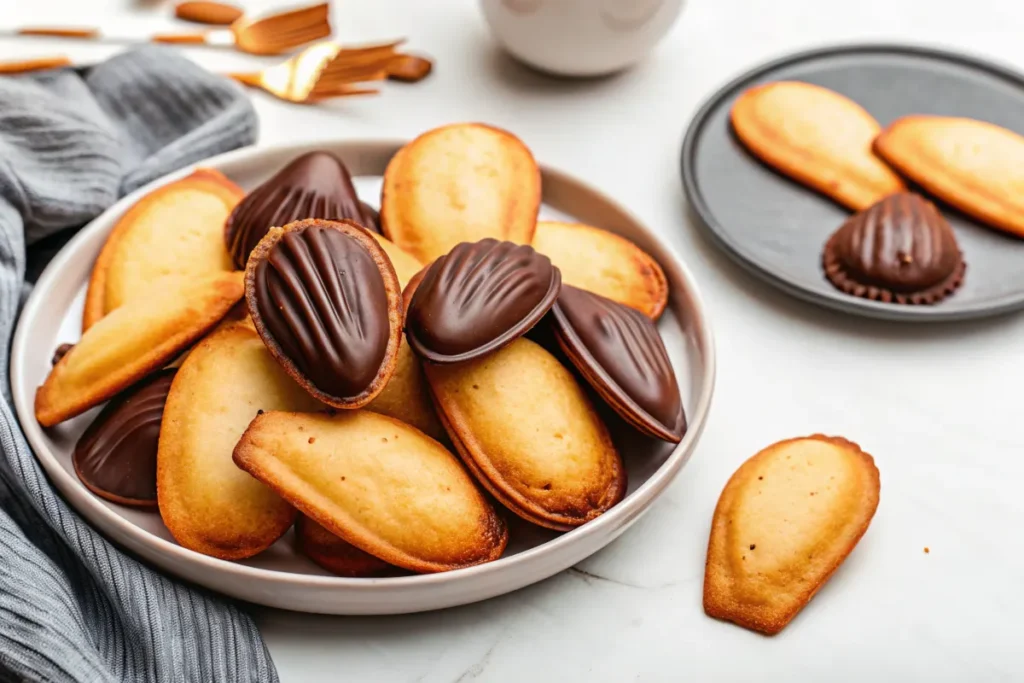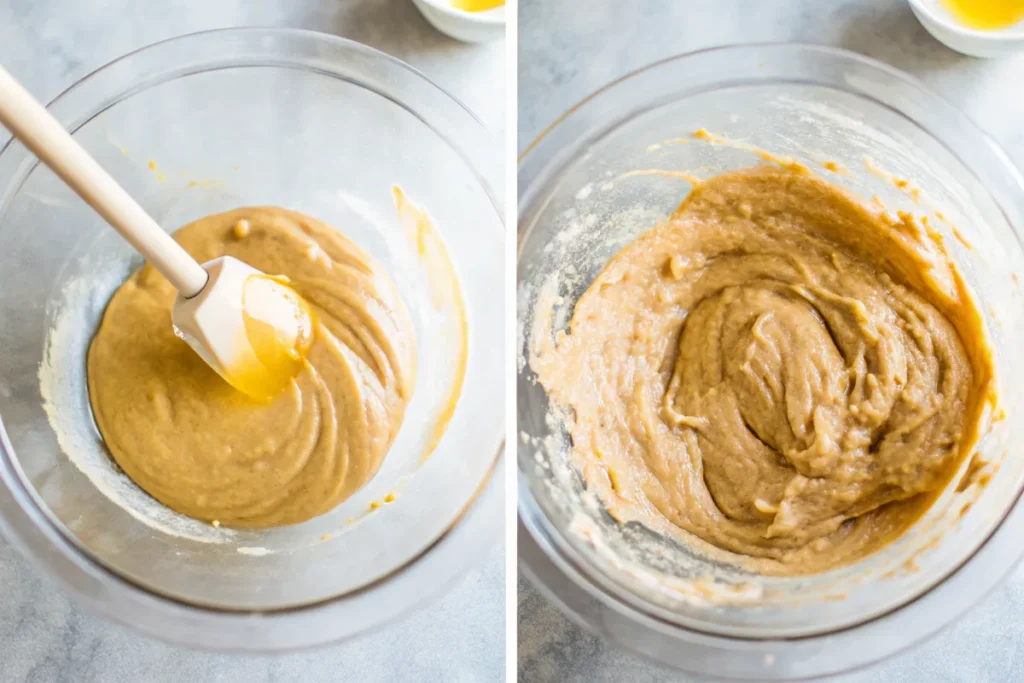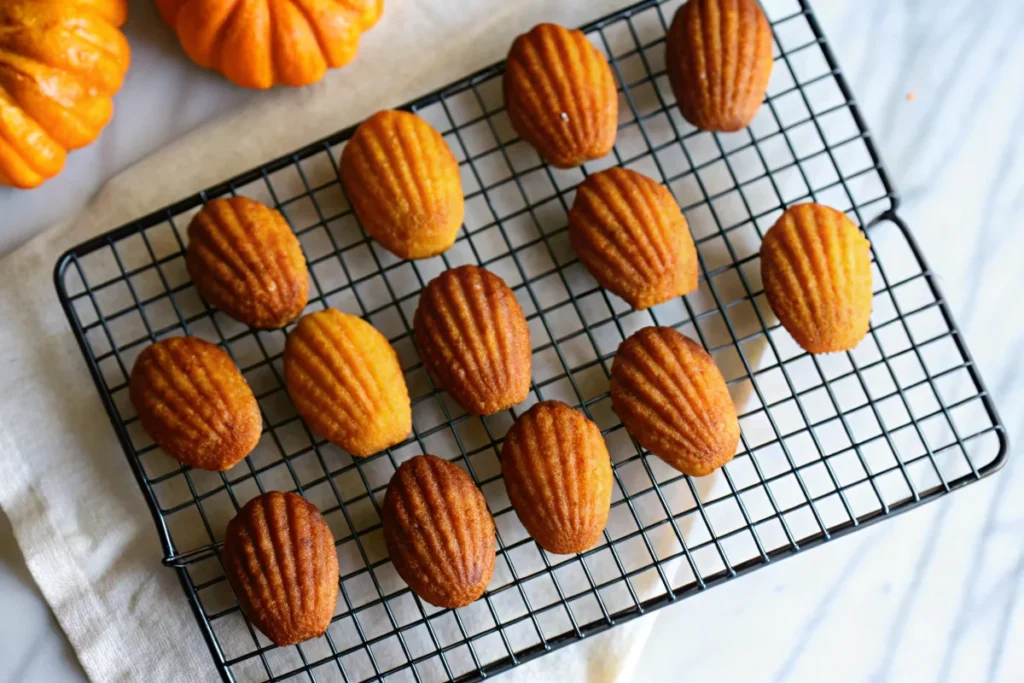Madeleines recipes have long enchanted dessert lovers with their soft, buttery texture and iconic shell shape. These petite French sponge cakes are more than just pastries—they’re an experience. Whether you enjoy them with a warm cup of tea or a bold espresso, madeleines recipes offer that delicate balance between richness and refinement. In this ultimate guide, we’re diving deep into everything you need to know about madeleines—from their French origins and how they differ from traditional cakes, to foolproof baking tips, creative flavor variations, and expert secrets from top pastry chefs.
You’ll also get a step-by-step recipe for classic madeleines recipes, tips for storing them properly, and insight into why these little treats are so irresistible. Whether you’re baking for a cozy brunch, a holiday gift, or just to treat yourself, mastering madeleines recipes is easier than you think.
Table of Contents

Classic French Madeleines
- Total Time: 27 minutes (plus chilling time)
- Yield: 12 madeleines 1x
Description
These Classic French Madeleines are soft, buttery sponge cakes with a golden shell-shaped exterior and a light, airy interior. Famous for their delicate texture and nostalgic charm, madeleines are a quintessential French treat. Perfect for serving with tea or coffee, these petite cakes are elegant, easy to make, and absolutely irresistible.
Ingredients
2 large eggs
½ cup (100g) granulated sugar
1 tsp vanilla extract
Zest of 1 lemon
1 cup (120g) all-purpose flour
½ tsp baking powder
½ cup (113g) unsalted butter, melted and cooled
Pinch of salt
Powdered sugar, for dusting (optional)
Instructions
In a large mixing bowl, beat the eggs and granulated sugar using a hand mixer on high speed until pale and fluffy (about 5–7 minutes).
Add the vanilla extract and lemon zest. Mix gently to incorporate.
In a separate bowl, sift together the flour, baking powder, and salt. Gently fold the dry ingredients into the egg mixture using a spatula.
Slowly pour in the melted, cooled butter and fold gently until fully combined. Do not overmix.
Cover the bowl and refrigerate the batter for at least 1–2 hours (or overnight for best results).
Preheat your oven to 375°F (190°C). Grease a madeleine pan with melted butter and lightly dust with flour.
Spoon or pipe the chilled batter into the molds, filling each one about ¾ full.
Bake for 10–12 minutes, or until the madeleines are puffed and the edges are golden.
Remove from the pan immediately and cool on a wire rack.
Dust with powdered sugar before serving, if desired.
Notes
For best results, use European-style butter and fresh lemon zest.
Batter can be made a day ahead and stored in the fridge.
Try variations like chocolate-dipped or lavender-infused madeleines for creative twists.
Madeleines are best enjoyed fresh, but they freeze well for up to 2 months.
- Prep Time: 15 minutes
- Cook Time: 12 minutes
- Category: Dessert
- Cuisine: French
Nutrition
- Serving Size: 1–2 madeleines
- Calories: 140 per madeleine
- Fat: ~8g
- Carbohydrates: ~15g
- Protein: ~2g
The Allure of Classic French Madeleines
The History and Origin of Madeleines
Madeleines recipes trace their roots back to 18th-century France, where these shell-shaped sponge cakes first appeared in the Lorraine region. Legend has it they were created by a young maid named Madeleine Paulmier, who served them to the exiled King Stanislas Leszczynski of Poland. He loved them so much, he named them after her. Later, when his daughter married Louis XV, the sweet little cakes found their way to the royal table—and into the hearts of the French people.
Madeleines recipes quickly became a symbol of French elegance and culinary finesse, especially in literary and artistic circles. Marcel Proust famously immortalized the treat in his novel In Search of Lost Time, where the taste of a madeleine dipped in tea evoked a flood of childhood memories. Since then, madeleines have been regarded as more than just a cake—they’re a piece of cultural nostalgia.
Why Madeleines Remain a French Baking Staple
What keeps madeleines recipes so beloved today? It’s their perfect balance of texture, taste, and simplicity. Light and airy yet rich with buttery flavor, madeleines walk the line between cookie and cake. Their distinctive shell shape—achieved with a special mold—gives them visual appeal, while the classic golden hue and tender crumb speak to their homemade charm.
Modern madeleines recipes have taken on countless variations, from citrus-infused batters to chocolate-dipped finishes. But no matter the twist, their base remains timeless. They’re easy to bake, versatile, and elegant enough for both everyday snacks and fancy occasions. Their small size makes them ideal for portion control, and their subtle flavor makes them a hit with both kids and adults.

Understanding the Difference – Madeleines vs Cakes
How Are Madeleines Different from Regular Cakes?
At first glance, madeleines recipes might seem like mini sponge cakes, but don’t be fooled—they’re in a category of their own. Unlike traditional cakes that are soft and moist throughout, madeleines have a crisp, golden-brown exterior paired with a light, buttery inside. This contrast in texture is part of what makes them so special.
One of the most noticeable distinctions is their signature hump on the back. That dome-shaped rise is not a baking accident—it’s intentional and marks a well-executed batter. It occurs due to the chilled batter hitting a hot oven, creating a burst of steam. You won’t find that in regular cake recipes.
Additionally, madeleines recipes are baked in shell-shaped molds, giving them their scalloped appearance—a far cry from the standard round or square cake pan. And while many cakes rely on frosting or fillings for flavor, madeleines let their ingredients shine through with simple yet rich flavors, like vanilla, lemon zest, and browned butter.
Texture, Shape, and Baking Technique Comparison
Let’s break it down in a quick comparison table:
| Feature | Madeleines | Traditional Cakes |
|---|---|---|
| Texture | Light with crisp edges | Uniformly soft or fluffy |
| Shape | Shell-shaped with a hump | Varies: round, square, layered |
| Portion Size | Single-serve, 2-3 bites | Sliced from larger whole |
| Baking Tools | Madeleines mold (shell pan) | Cake tins or springform pans |
| Flavor Profile | Subtle, buttery, lightly citrus | Can include frosting or fillings |
So while both desserts satisfy your sweet tooth, madeleines recipes offer a more artisanal, bite-sized experience rooted in French technique.
So if you’re looking to try something more elegant and unique, madeleines recipes are a delightful alternative to everyday cakes.
Click here for 7 Secrets to Making the Perfect Chocolate Mayonnaise Cake!
Key Ingredients in Madeleines Recipes
What Are Madeleines Made Of?
At their core, madeleines recipes use simple pantry staples that, when combined just right, create their unique flavor and texture. Unlike overly complex desserts, madeleines rely on quality over quantity. Here’s what goes into a traditional batch:
- Eggs: These provide structure and richness. Beating them properly incorporates air, contributing to the sponge-like texture.
- Granulated Sugar: Not only does it sweeten the batter, but it also helps create that delicate crust.
- All-Purpose Flour: This is the base of the batter, creating a soft crumb when sifted properly.
- Butter: Melted and slightly cooled, it adds a rich, golden flavor. Browned butter is a secret upgrade for extra depth.
- Baking Powder: While traditional French recipes sometimes skip it, modern ones use a pinch for that signature rise.
- Lemon Zest or Vanilla Extract: These subtle flavor enhancers are what give madeleines their refined, elegant taste.
It’s not about adding more—it’s about using better. Fresh organic eggs, real vanilla, and European-style butter can take your madeleines from good to unforgettable.
Choosing Quality Ingredients for Authentic Flavor
Madeleines may look simple, but their flavor depends on every ingredient being top-notch. Always opt for:
- Unsalted butter: Gives you control over the flavor balance.
- Freshly grated lemon zest: Avoid bottled extracts if you want a bright, citrusy punch.
- High-protein flour: Gives madeleines a slightly chewy interior without being dense.
- Free-range eggs: These whip up fluffier and add richness in both taste and color.
Want to elevate your game? Try lavender honey, orange blossom water, or almond flour for unique twists.
The Art of Baking Madeleines
Essential Baking Tools and Pans
If you’re serious about madeleines recipes, investing in the right equipment is key. These tools ensure precision and perfect presentation every time.
- Madeleine Pan: This is non-negotiable. It’s the secret to the classic shell shape and the golden crisp edges. Non-stick metal pans work best, but traditional blue steel pans offer deeper browning.
- Piping Bag or Small Scoop: Helps distribute the batter evenly into molds without making a mess.
- Mixing Bowls (preferably metal or glass): Keeps your batter cool during the folding process.
- Microplane Zester: Ideal for extracting vibrant citrus flavors from lemons or oranges.
Pro Tip: Brush the pan with melted butter and dust it lightly with flour before filling to prevent sticking and encourage that beautiful crust.
Baking Tips for Achieving the Perfect Hump and Texture
One of the hallmarks of a successful madeleines recipe is the little hump that rises on the back. But this isn’t just about looks—it’s a sign you nailed the process. Here’s how to get that hump and dreamy texture:
- Chill the batter for at least one hour (overnight is better). This firms it up and helps with that initial rise when the batter hits the heat.
- Preheat your oven properly. A hot oven (375°F or 190°C) gives an initial blast of heat that creates steam, which puffs up the center.
- Don’t overmix. Fold the flour and butter gently to preserve the air you whipped into the eggs.
- Only fill each mold 3/4 full. This gives the batter space to rise and form its hump.
- Rotate the tray halfway through baking to ensure even browning.
How to Make Classic French Madeleines
Step-by-Step Madeleines Recipe with Visuals
If you’re new to baking or want to perfect your technique, this classic madeleines recipe is a foolproof place to start. Soft, buttery, and beautifully golden, these little cakes come together with a few basic steps.
Ingredients:
- 2 large eggs
- ½ cup granulated sugar
- 1 tsp vanilla extract
- Zest of 1 lemon
- 1 cup all-purpose flour
- ½ tsp baking powder
- ½ cup unsalted butter (melted and cooled)
- Pinch of salt
Instructions:
- Whip the eggs and sugar in a large bowl until pale and fluffy (about 5–7 minutes using a hand mixer).
- Add vanilla extract and lemon zest. Mix gently.
- Sift the flour, baking powder, and salt, then fold it into the egg mixture using a spatula. Do not overmix.
- Slowly pour in the melted butter, folding gently until fully incorporated.
- Cover and chill the batter in the fridge for 1–2 hours.
- Preheat your oven to 375°F (190°C). Grease your madeleine pan with melted butter and dust with flour.
- Spoon or pipe batter into each mold, filling ¾ full.
- Bake for 10–12 minutes, or until the madeleines are puffed with golden edges.
- Remove from pan immediately and cool on a wire rack.

Sprinkle with powdered sugar if desired, and enjoy with tea or espresso.
These madeleines recipes work well for both beginners and seasoned bakers—and once you’ve mastered the classic version, it opens the door to creative flavor twists.
Troubleshooting Common Baking Mistakes
Even simple madeleines recipes can go sideways without the right techniques. Here’s how to fix some common baking issues:
| Problem | Likely Cause | Solution |
|---|---|---|
| Flat madeleines | Batter wasn’t chilled enough | Chill for at least 1 hour before baking |
| No hump | Oven not hot enough at the start | Preheat oven thoroughly to 375°F |
| Dry texture | Overbaked or overmixed batter | Bake for less time and fold gently |
| Madeleines stuck in mold | Pan wasn’t properly greased and floured | Brush butter and lightly flour molds |
| Uneven browning | Uneven heat in oven | Rotate pan halfway through baking |
Irresistible Madeleines Variations to Try
Lemon, Chocolate, Lavender, and Honey Madeleines
Once you’ve nailed the basics, it’s time to have some fun. One of the best things about madeleines recipes is how adaptable they are. Try these creative spins to impress your guests—or treat yourself to something new:
- Lemon Madeleines: Add extra zest and a light lemon glaze for a bright citrus bite.
- Chocolate Dipped Madeleines: After cooling, dip half the madeleine in dark chocolate and let it set.
- Lavender Honey Madeleines: Infuse your melted butter with dried culinary lavender and replace sugar with honey.
- Matcha Madeleines: Add 1 tbsp of culinary matcha powder for a vibrant color and earthy flavor.
These versions retain the core soft texture and shape while introducing new flavors and aromas that elevate the traditional French sponge cake.
Vegan, Gluten-Free, and Spiced Versions
If you follow a special diet, you don’t have to miss out on delicious madeleines recipes. Bakers around the world have created amazing versions that fit all kinds of preferences:
- Vegan Madeleines: Replace eggs with aquafaba and use dairy-free butter alternatives. Add a touch of almond milk for smoothness.
- Gluten-Free Madeleines: Substitute all-purpose flour with almond flour or a gluten-free baking mix.
- Spiced Brown Butter Madeleines: Brown your butter with a pinch of cinnamon, nutmeg, and ginger—perfect for the holidays.
The key is to maintain the batter’s lightness while working with alternatives. These adjustments keep the texture close to the original while offering variety for every lifestyle.
What Makes Madeleines So Good?
Taste, Texture, and Nostalgia Factor
It’s not just the ingredients or the pretty shell shape—madeleines recipes are beloved because they strike a perfect balance of sensory delight and emotional comfort. Let’s break down why they’re so darn good:
- Texture: They’re soft and fluffy on the inside with a delicate, buttery crust on the outside. That contrast creates a mouthfeel that’s incredibly satisfying.
- Flavor: A rich, buttery base flavored with citrus or vanilla makes them subtle but memorable. No need for frosting or fillings.
- Aroma: The scent of warm madeleines, fresh from the oven, fills your kitchen with sweet, buttery goodness that’s irresistible.
- Portion & Presentation: One or two bites is all you need. Their elegant shape makes them perfect for gifting, tea parties, or even weddings.
But there’s also something emotionally satisfying about madeleines. As Marcel Proust famously described, a single bite can unlock vivid memories. Whether you first tried them in a cozy bakery or baked them with family, madeleines carry a nostalgic charm that lingers far beyond dessert.
Pairings: Tea, Coffee, and Wine Options
The elegance of madeleines extends to how they’re served. Depending on the time of day—or the mood—they pair beautifully with a range of drinks:
| Pairing Type | Best Match |
|---|---|
| Tea | Earl Grey, chamomile, or jasmine tea enhance the delicate flavors. |
| Coffee | Espresso and cappuccino offer a rich contrast to the light sponge. |
| Wine | A chilled glass of Moscato or sweet white wine pairs well with citrusy versions. |
| Non-alcoholic | Lemonade or warm milk is perfect for a comforting, kid-friendly combo. |
Try switching pairings based on your madeleines recipe variation—lavender madeleines with green tea, or chocolate dipped ones with a bold red wine.
Serving and Storing Your Madeleines
How to Serve Madeleines Like a Parisian Pâtisserie
French desserts are about more than flavor—they’re about presentation and experience. To serve madeleines recipes with authentic flair:
- Warm them slightly before serving for a just-baked feel.
- Arrange on a tiered cake stand or white ceramic platter to highlight their golden shell shape.
- Dust lightly with powdered sugar right before serving for a classic touch.
- Pair with matching linens and vintage tea sets to create a charming French café vibe.
Hosting a brunch? Madeleines also look gorgeous on dessert grazing boards with fresh berries and jam. They fit beautifully into both casual and upscale settings.
Storage Tips to Maintain Freshness and Flavor
Madeleines are best eaten fresh, but with the right storage, you can enjoy them for days. Here’s how:
- Room Temperature: Store in an airtight container for up to 3 days. Place a paper towel inside to absorb moisture.
- Freezer: Madeleines freeze well! Wrap them individually in plastic wrap, then place in a zip-top bag. They’ll last for up to 2 months.
- Reheating: Warm in the oven at 300°F for 3–4 minutes to restore softness. Avoid microwaving—they may turn rubbery.
Pro Tip: For flavored varieties like chocolate or lavender, store separately to preserve the unique aromas.
Expert Secrets From Top Bakers
Pro Tips from Julia Child, David Lebovitz, and More
When it comes to madeleines recipes, mastering the small details is what sets a home baker apart from a pâtisserie pro. Legendary chefs like Julia Child and David Lebovitz have all shared their wisdom on what makes the perfect madeleine. Let’s break down their top advice:
- Julia Child emphasized temperature control. She chilled her batter and made sure the oven was preheated to exact degrees, resulting in a perfectly puffed hump every time.
- David Lebovitz, a Paris-based pastry expert, recommends using French flour and browned butter (beurre noisette) for deep, nutty flavor.
- Cindy Mushet, another acclaimed pastry chef, swears by infusing her batter with floral waters like orange blossom for subtle complexity.
These experts agree: don’t skip the chill, treat your ingredients with care, and experiment once you’ve mastered the base madeleines recipes.
Using Browned Butter and Infused Syrups for Extra Flair
Want to elevate your madeleines recipes beyond the classic? These two techniques take flavor and aroma to a whole new level:
- Browned Butter (Beurre Noisette)
Melt your butter over medium heat until it turns golden and smells nutty. Let it cool slightly before adding to your batter. The result? A deep, caramelized richness that transforms the entire cake. - Infused Syrups or Floral Additions
Mix a teaspoon of lavender syrup, rose water, or orange blossom water into your batter for elegant twists. These delicate notes add a subtle fragrance without overpowering the buttery core.
Bonus Tip: Add crushed pistachios, shaved almonds, or even a dab of jam to the center of your madeleines before baking for visual and textural contrast.
Frequently Asked Questions (FAQ)
How are madeleines different from cakes?
Madeleines may look like mini cakes, but their texture and structure are unique. Unlike traditional cakes, madeleines are crisp on the outside, airy on the inside, and baked in a shell-shaped mold, giving them a signature hump.
What are madeleines recipes made of?
Most madeleines recipes use basic ingredients like eggs, flour, sugar, butter, and lemon zest. The magic comes from technique—whipping the eggs well and chilling the batter help achieve the perfect light texture and rise.
What makes madeleines so good?
It’s the blend of rich buttery flavor, soft sponge-like texture, and delicate presentation. Whether enjoyed plain or with a twist, madeleines are simple yet luxurious—a true French treat.
How to make classic French madeleines?
Start by whipping eggs and sugar, then fold in flour, baking powder, lemon zest, and cooled melted butter. Chill the batter, then bake in greased shell molds at 375°F. The result: golden, puffed cakes with a crisp edge and soft center.

Conclusion: Your Perfect Madeleines Await
Whether you’re a beginner or a seasoned home baker, madeleines recipes open the door to elegant, bite-sized perfection. With just a few simple ingredients and the right techniques, you can recreate the magic of a French bakery using traditional madeleines recipes.
From mastering the classic sponge to experimenting with flavors like matcha and honey lavender, these madeleines recipes never stop delighting. Serve them with tea, gift them to friends, or freeze a batch for later—you’ll always be glad you did.
Don’t miss How to Perfect the Madeleine Cookie Recipe – A Beginner’s Guide for visual support
